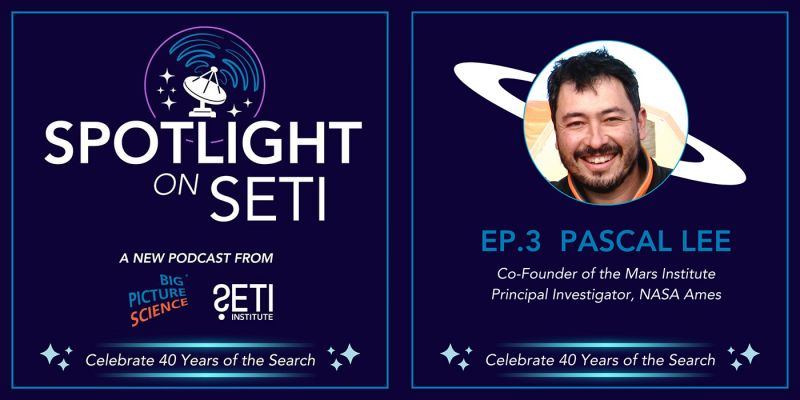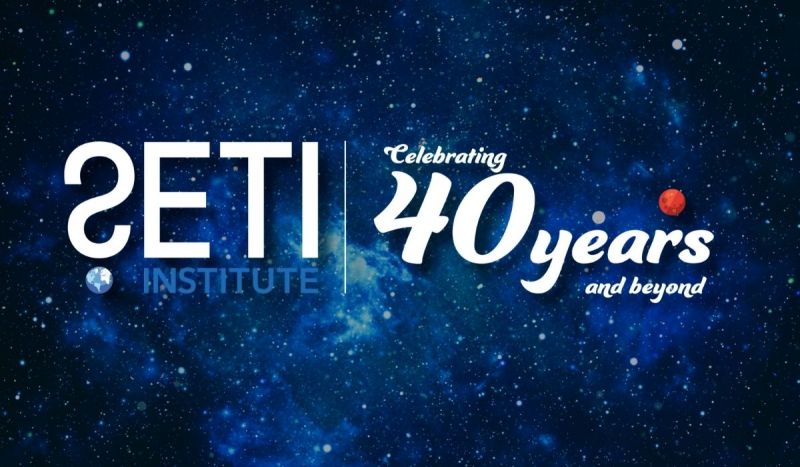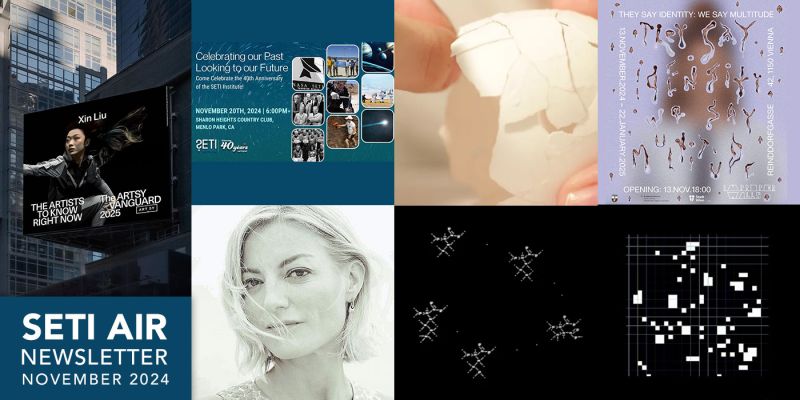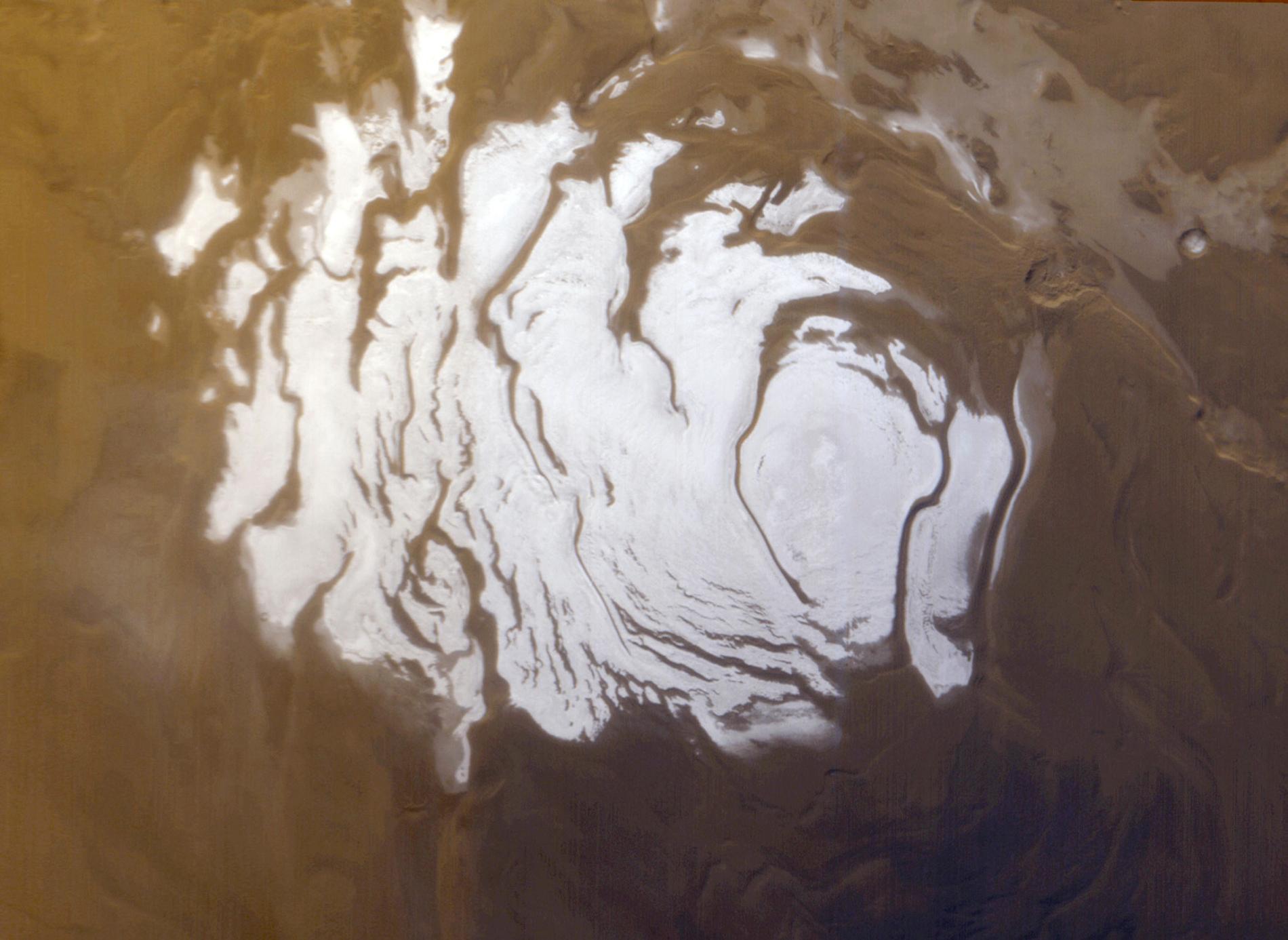
Exciting data has been reported in the journal Science, revealing that radar scans of Mars indicate the presence of liquid salt water a mile beneath the surface of the red planet’s southern pole. The presence of the underground lake still needs to be confirmed, but it’s promising news for astrobiologists hoping to locate environments that may provide conditions that cold host life.
Local television station KTVU visited the SETI Institute to get insight on the findings from Director of the Carl Sagan Center for the Study of Life in the Universe, Nathalie Cabrol. Cabrol described the findings as “really, really exciting”, and spoke about its importance to future Mars missions and the need for better sterilization practices for any spacecraft from Earth sent to explore the region. Cabrol elaborated on these topics in a quote for National Geographic:
“What you see here is potentially the presence of water, of shelter ... and you’re going to produce nutrients out of the minerals,” she says. “What you need is a source of energy … and if there were recent volcanoes in the polar regions, then this is definitely a place that would become a high habitability and life target.”
On the other hand, she notes, “it would be a very problematic place to go, because it would be under the special regions for planetary protection,” she says, referring to the UN regulations aimed at preventing interplanetary contamination of habitable environments.
Microbial life has been uncovered on Earth under extreme conditions, deep beneath the Antarctic’s glacial ice and in the high Andes, and researchers suspect that if life, or evidence of past life, is to be found on Mars it will likely be discovered in regions with comparable features.
- KTVU: Water is buried beneath Martian landscape, study says
- National Geographic: Underground Lake Found on Mars? Get the Facts.
- CBC Radio: Why tiny microbes could be the key to the search for life on Mars
- Outer Places: Huge Underground Lake of Liquid Salt Water Discovered Buried on Mars' South Pole – Here's Everything You Need to Know
- Science: Radar evidence of subglacial liquid water on Mars
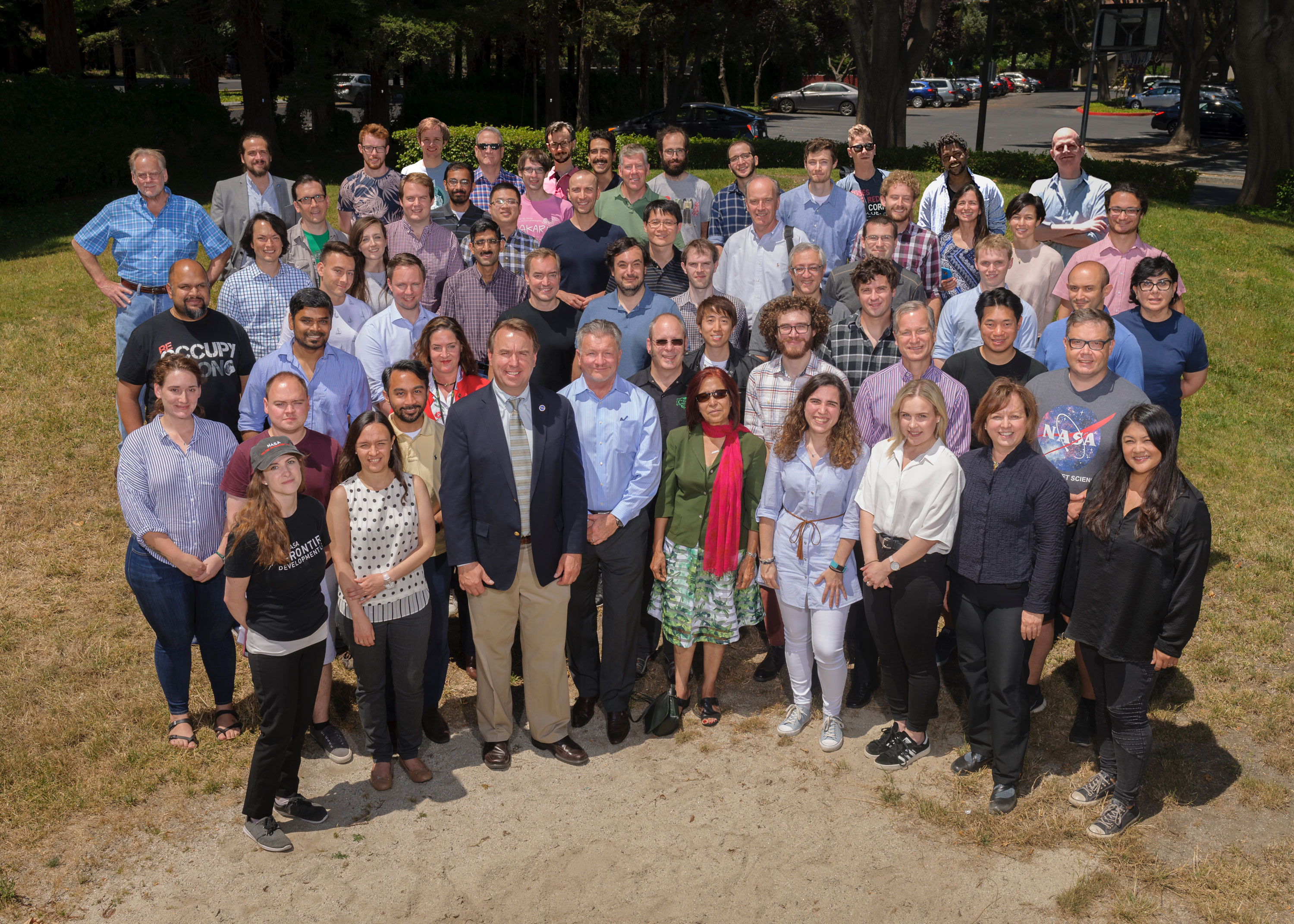 Frontier Development Lab Uses Machine Learning to Tackle Space Weather
Frontier Development Lab Uses Machine Learning to Tackle Space WeatherThe Huffington Post recently featured the work of the NASA Frontier Development Lab (FDL) – FDL is an AI/machine learning research accelerator powered by a public/private partnership between NASA, the SETI Institute, and commercial leaders in AI and pioneers in the private space industry.
Bringing together the best technological minds from across the world, the FDL tackles space science head-on, deploying specialised machine learning techniques to help protect the planet from space weather.
In addition to tackling challenges in space weather (such as predicting the disruptions to Earth’s atmosphere by solar flares), FDL 2018 is addressing challenges in the areas of Astrobiology, Exoplanets and Space Resources.
The 2018 FDL participants will be present their findings in August, at Intel’s headquarters in Santa Clara, California.
- Huffington Post: Using Machine Learning to Predict the Trillion Dollar Solar Storm
- Mountain View Voice: NASA, SETI seek to harness AI tools
 New Moons, Young Moons
New Moons, Young MoonsWhile small moons are still being discovered (12 newly discovered moons around Jupiter were announced just last week by the International Astronomical Union), it appears that a number of larger moons have been lost over the history of our solar system. Astronomers believe that not only was the early solar system chaotic, but there may have been collisions of moons and planets relatively (cosmically speaking) recently, as SETI Institute Research Scientist Matija Cuk explained in a recent Discover article:
“It’s not mainstream yet, but it’s gaining credibility that both the rings and the moons (of Saturn) are the results of collisions a few hundred million years ago,” Cuk says. In 2016, he authored an Astrophysical Journal study suggesting that Saturn’s inner moons are quite young.
Other moons with more distant orbits around Saturn are believed to be older, perhaps as old as the solar system itself. You can read more about why researchers suspect Saturn’s rings may have formed around the same time as Earth’s Cretaceous Period on our website, SETI.org.
- Discover Magazine: Exploring the Lost Moons Of Our Solar System
- SETI.org: Moons of Saturn May Be Younger Than the Dinosaurs
- Curiosity: 12 New Moons of Jupiter Have Just Been Discovered
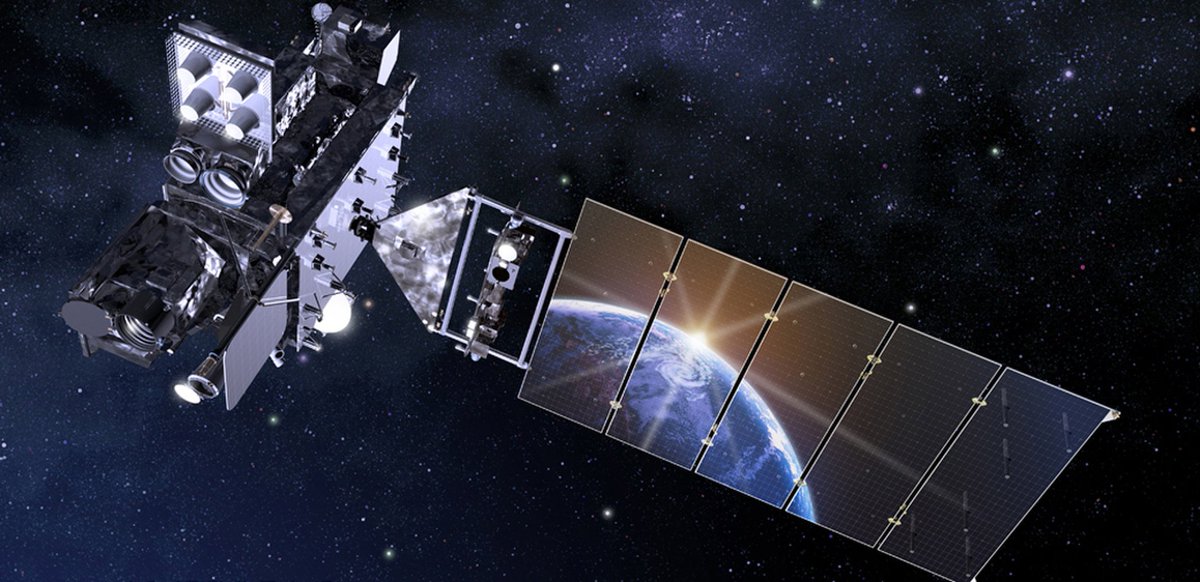 Fire in the Sky: Using Weather Satellites to Track Bright Meteors
Fire in the Sky: Using Weather Satellites to Track Bright MeteorsSatellite-mounted weather monitors designed to track lightning strikes may provide astronomers with a way to track the flash of meteoroids burning as they impact Earth’s atmosphere. Peter Jenniskens, Senior Research Scientist at the SETI Institute is lead author of a new paper showing that bolides (bright fireballs) can be detected by the Geostationary Lightning Mapper (GLM) onboard the GOES-16 weather satellite. Jenniskens spoke to Space.com about the phenomenon:
"If you've ever seen one of these events, they are spectacular," he told Space.com. But he isn't just enjoying the light show; he's worried about planetary protection. That means he wants to know as much as possible about which asteroid characteristics trigger which impact characteristics.
The data already collected by the satellite researchers have allowed researchers to identify 10 meteors, and offering new insight into the nature of these impacts:
Jenniskens said he was particularly surprised that different impacts created different light shows — some with dramatic flaring and dimming, and others with much steadier burns. That's probably related to an asteroid's composition and structure, which would affect how it falls through the atmosphere, he said.
Those are difficult properties to measure in space, but tracking individual asteroids and their re-entry displays could help scientists begin to connect those dots. "Maybe we'll learn in time to predict how a particular asteroid would break apart in the atmosphere," Jenniskens said.
You can read more about Peter Jenniskens work, including his recent recovery of a meteorite in Botswana, at SETI.org.
- Space.com: Flash, Bam, Alakazam: Lightning-Detecting Satellite Also Spots Meteors
- Wiley Online Library: Detection of meteoroid impacts by the Geostationary Lightning Mapper on the GOES‐16 satellite
- SETI.org: Scientist Interview - Peter Jenniskens
- SETI.org: Fragment of Impacting Asteroid Recovered in Botswana
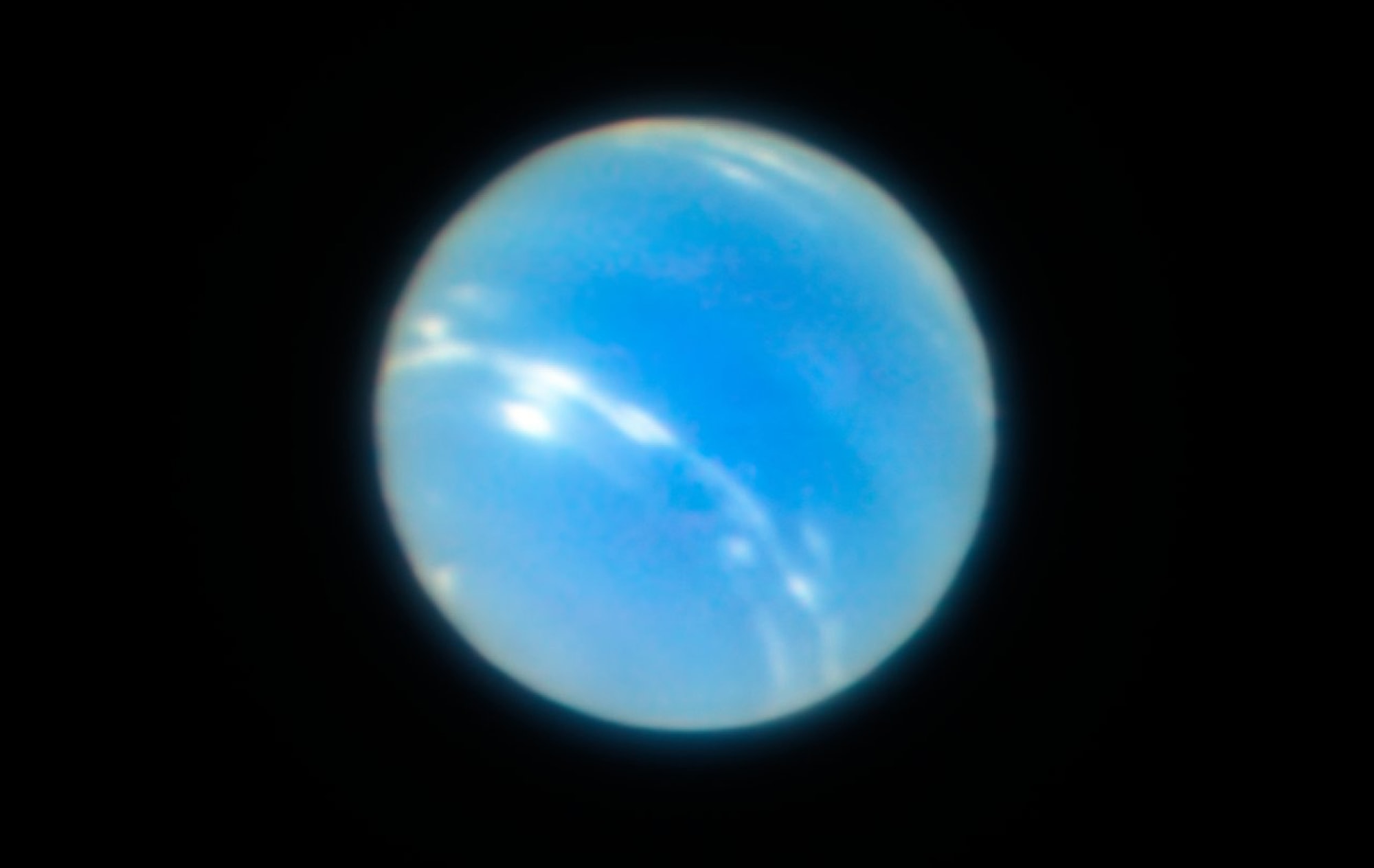 Adaptive Optics Upgrade Earth-based Observations
Adaptive Optics Upgrade Earth-based ObservationsRecent upgrades to the powerful Very Large Telescope (VLT) in Chile have allowed it to capture stunningly detailed images that some scientists say rivals those of the Hubble Space Telescope, long regarded as one of the most versatile and vital research tools in astronomy. Using a technique called adaptive optics, which enables real-time corrections for the distortions of Earth’s atmosphere, astronomers can now observe distant objects with far greater detail than is usually possible from the ground. Mark Showalter, Senior Research Scientist and Fellow at the SETI Institute, praised the upgrade in an NBC News MACH article:
“I have used the Hubble telescope on Neptune numerous times, and these images are every bit as sharp,” astronomer Mark Showalter, a senior research scientist at the SETI Institute in Mountain View, California, told NBC News MACH in an email. “If they’ve turned the VLT into a second Hubble, then we can all do more cutting-edge astronomy.”
Once the upgrades are fully realized, a wide array of distant celestial objects will be studied in remarkable detail, offering astronomers who vie for the limited observing time on Hubble an additional resource for studying the skies.
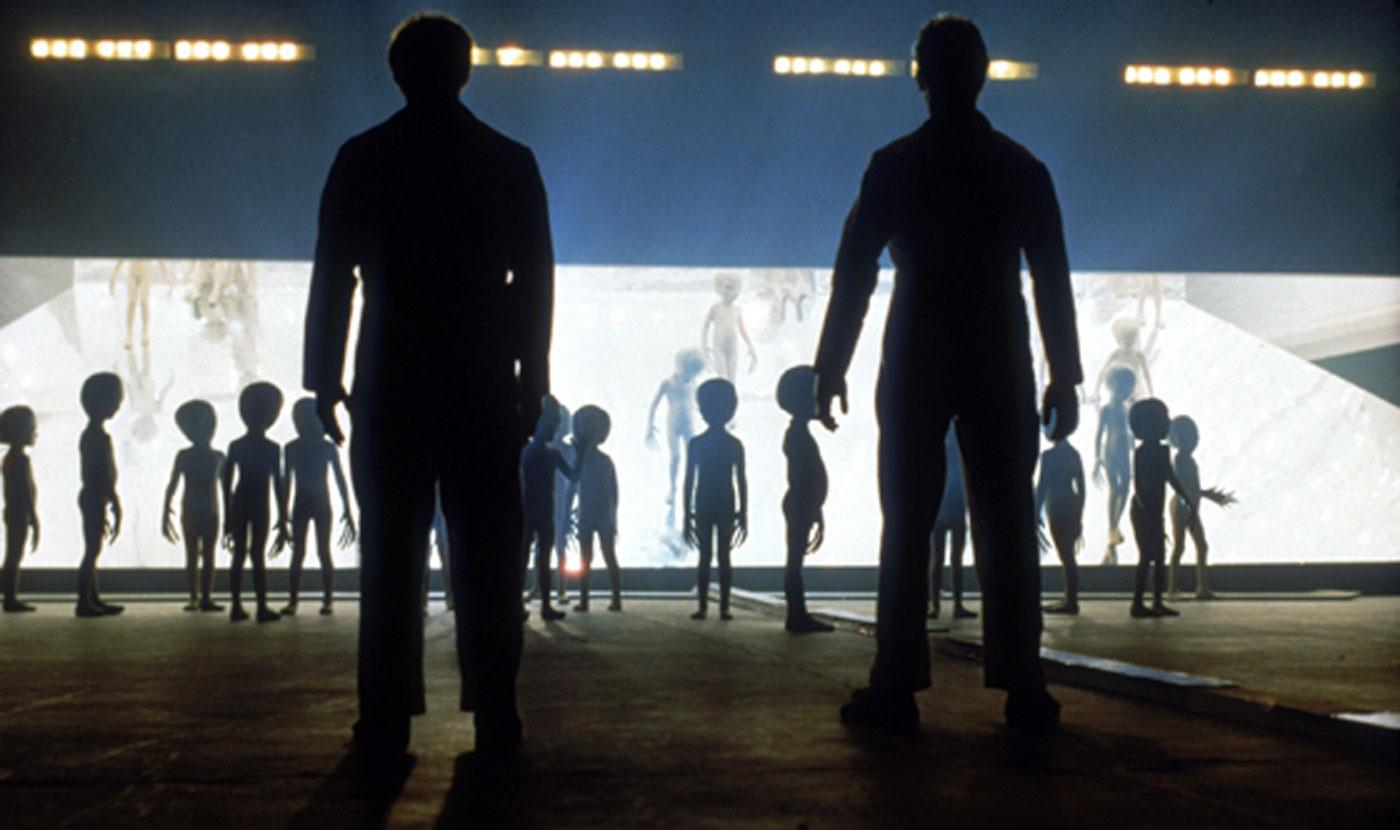 The Retooled Rio Scale
The Retooled Rio ScaleThe Rio Scale was developed in 2001 as a way of ranking the credibility of any claim of extraterrestrial detection, in order to help the public know how significant experts determine the claim to be. GeekWire covered the story, and quoted Jill Tarter, Chair Emeritus for SETI Research at the SETI Institute and co-author of a new study published in the International Journal of Astrobiology, on the latest update to the Rio Scale:
“The whole world knows about the Richter scale for quantifying the severity of an earthquake; that number is reported immediately following a quake and subsequently refined as more data are consolidated,” Jill Tarter, co-founder of the SETI Institute, said today in a news release.
“The SETI community is attempting to create a scale that can accompany reports of any claims of the detection of extraterrestrial intelligence and be refined over time as more data become available,” said Tarter, who’s one of the researchers behind Rio 1.0 and 1.1 as well as Rio 2.0.
The new scale depends on more detailed questions to judge a claim, but still results in a simple ranking to enable researchers to quickly and clearly inform the public of the value of any discoveries.
- International Journal of Astrobiology: Rio 2.0: Revising the Rio Scale for SETI Detections
- SETI.org: How can you tell if that ET story is real? St. Andrews scientists revise the Rio Scale for alien encounters
- GeekWire: Scientists come up with revised ‘Rio scale’ to rate claims of extraterrestrial contact
- Phys.org: Scientists revise the Rio Scale for reported alien encounters
- Cambridge University Press: Rio 2.0: revising the Rio scale for SETI detections
 Life as We Know It
Life as We Know ItWhen astrobiologists search for life in the universe, they often start by looking for the same sort of things we’d find on Earth; for example, carbon-based molecules and the liquid water life depends on. Curiosity recently spoke to the SETI Institute’s Senior Astronomer, Seth Shostak, about why the hunt for aliens starts with the familiar:
"Carbon-based chemistry works great — we know what to look for," Seth Shostak, Senior Astronomer at the SETI Institute, told us on our podcast, the Curiosity Daily. "So maybe we can be forgiven, as it were, for looking for life that's more like life as we know it than life as we don't know it."
Exploring the bounds of life on Earth and developing our understanding of biochemistry allows researchers to focus efforts on areas that are, to the best of our current knowledge, likely to produce findings. However, “life as we don’t know it” is also part of the SETI Institute’s multidisciplinary approach the exploring life in the universe. In early 2018, experts from a wide variety of fields converged on the SETI Institute’s Silicon Valley headquarters to tackle the challenge of thinking “outside of our own brains”, as astrobiologist Nathalie Cabrol, Director of the Carl Sagan Center for the Study of Life in the Universe, put it. The conference, dubbed “Decoding Alien Intelligence” called for a new SETI blueprint and vision as leading experts collaborated to expand our ways of understanding the cosmos.
- Curiosity: Why Are Alien Hunters Looking for the Same Things That Support Life on Earth?
- Daily Galaxy: Decoding Alien Intelligence --"The Search for Life as We Don't Know It"
- Facebook: Decoding alien intelligence with Nathalie Cabrol and Bill Diamond (video)
 Are We Alone? The Theory vs. the Search
Are We Alone? The Theory vs. the SearchIn an article for NBC News MACH, Seth Shostak, Senior Astronomer at the SETI Institute, discusses a recent paper that suggest existing estimates for the prevalence of life in the universe are too optimistic. The paper’s authors argued that since so many variable are yet unknown, and therefore the probability of intelligent life being found might bequite low. However, as Shostak notes, that estimate would change dramatically if even a microbe were to be discovered on a moon in our own solar system. Shostak cautions against being dissuaded from investigating our universe:
Frankly, exploration is seldom done well on blackboards. For 2,000 years academics argued over the possibility that a continent-size land mass sat at the bottom of the globe… you don’t make new discoveries by computing probabilities, only by investigating — by actually doing an experiment. In the case of the Antarctica hypothesis, that meant sending ships south.
As we explore and learn about the universe, it’s clear that there is more to be discovered.
- NBC News MACH: Are we truly alone in the cosmos? New study casts doubt on rise of alien life in our galaxy
In last week’s episode, learn why DNA, believed by many to be the best form of identification, doesn’t tell the whole story in Identity Crisis. On our previous week’s episode Seth and Molly discuss the importance of ice to life on our world, and the growing concern about it disappearing across the globe, in an encore of On Thin Ice.
Last week on Facebook Live, meet the Exoplanet and Astrobiology research teams in Frontier Development Lab (FDL) as they discuss their projects with SETI Institute Trustee and FDL Ideation Director Jonathan Knowles. On our previous episode of Facebook Live, find out what “space weather” is and meet the FDL research team members working on heliophysics, with SETI Institute Trustee Jonathan Knowles. Videos of all past Facebook Live events can be found on our Facebook page: https://www.facebook.com/SETIInstitute/
- In Saturn’s Rings: August 5, Seattle, WA A new film exploring Saturn’s rings is being shown at the Museum of Flight. Nathalie Cabrol, Senior Research Scientist and Director of the Carl Sagan Center is an executive producer of the film.
- Novato Space Festival: August 5, Novato, CA Jill Tarter book signing
- SETI Talks: August 14, Menlo Park, CA Inspiring the Next Generation of Explorers – Education Programs at the SETI Institute
- WorldCon 76: August 16-20, San Jose, CA Franck Marchis to participate in a panel discussion
- International Astronomical Union: August 20-31, Vienna, Austria Franck Marchis, SETI Institute Senior Scientist will speak about adaptive optics and the Unistellar eVscope
- Our Journey Towards Mars: September 10, San Francisco, CA: SETI Institute scientist JR Skok will speak at the California Academy of Sciences
- Astronomy Night: Searching for Aliens, Finding Ourselves: September 15, Mill Valley, CA Jill Tarter is the featured speaker
- Institute of Geophysics and Planetary Physics: September 28, Santa Cruz, CA SETI Institute scientist JR Skok will give a talk about the search for life in the Martian Hot Springs
- The World Above the Tetons Science Speaker Series: September 29, Teton Village, WY Jill Tarter will present Communicating Beyond Earth

